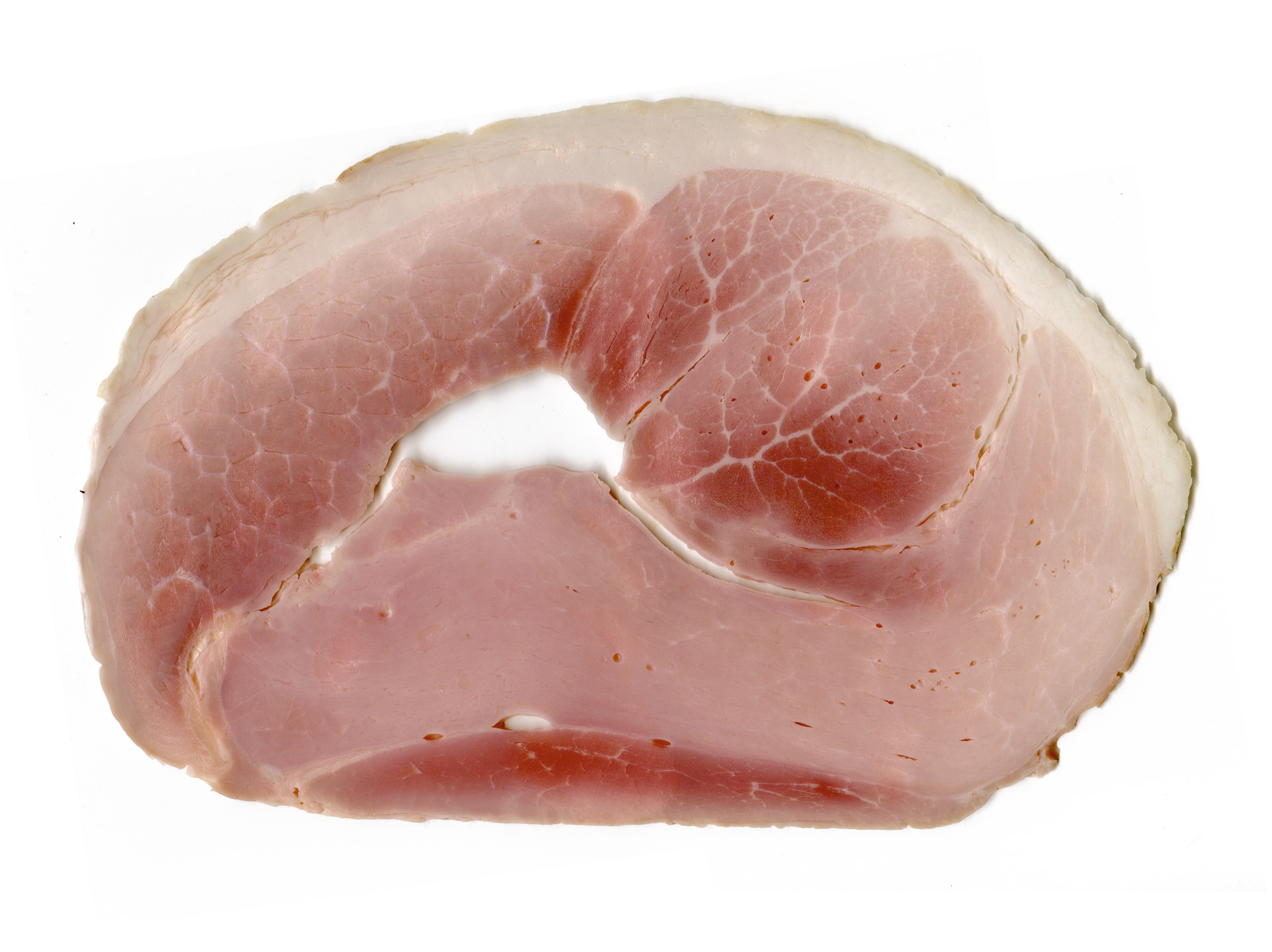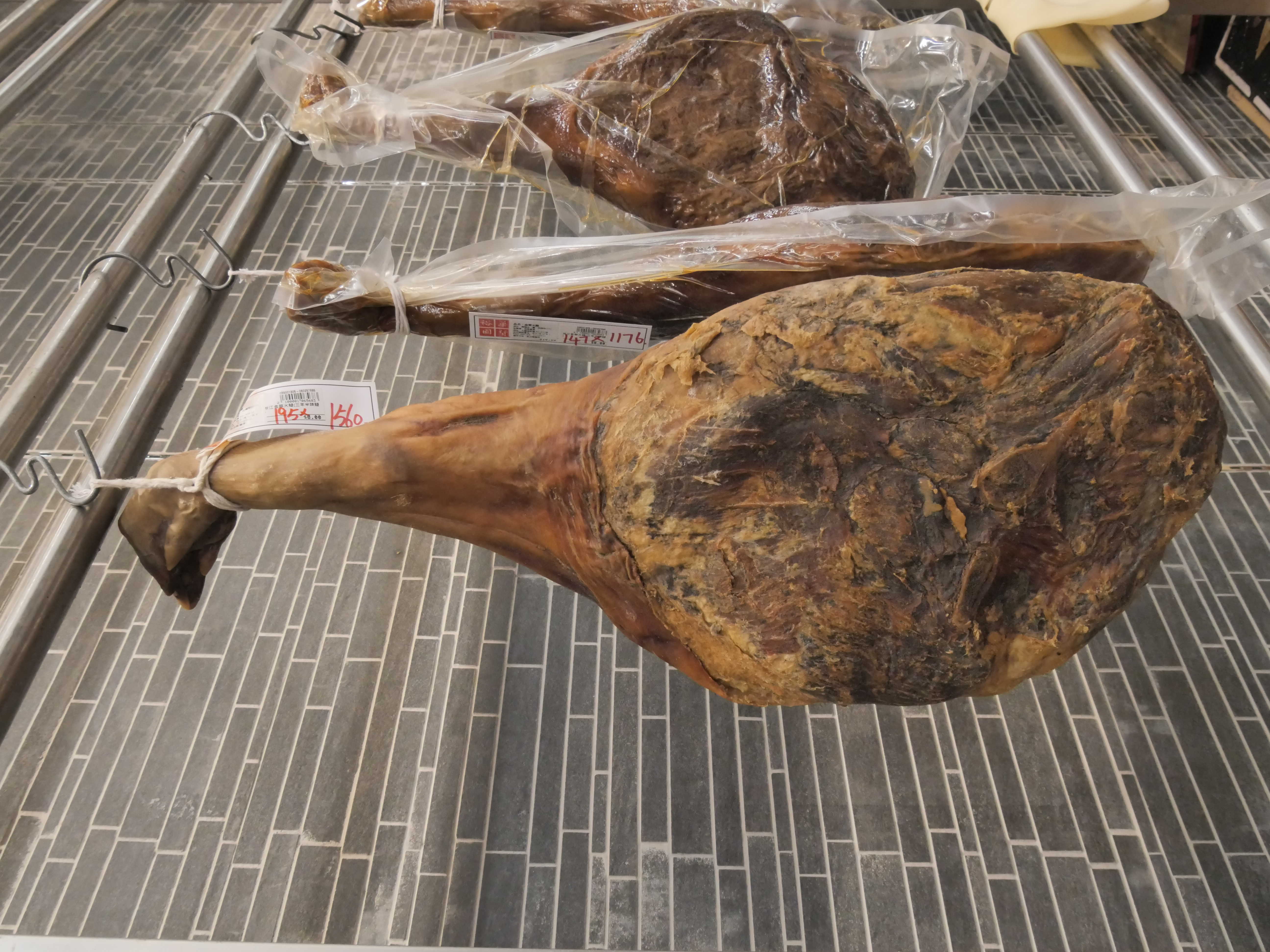|
Hams
Ham is pork from a leg cut that has been preserved by wet or dry curing, with or without smoking."Bacon: Bacon and Ham Curing" in ''Chambers's Encyclopædia''. London: George Newnes, 1961, Vol. 2, p. 39. As a processed meat, the term ''ham'' includes both whole cuts of meat and ones that have been mechanically formed. Ham is made around the world, including a number of regional specialties. In addition, numerous ham products have specific geographical naming protection. History The preserving of pork leg as ham has a long history, with traces of production of cured ham among the Etruscan civilization known in the 6th and 5th century BC. Cato the Elder wrote about the "salting of hams" in his ' tome around 160 BC. There are claims that the Chinese were the first people to mention the production of cured ham. ' claims an origin from Gaul. It was certainly well established by the Roman period, as evidenced by an import trade from Gaul mentioned by Marcus Terentius Varro in ... [...More Info...] [...Related Items...] OR: [Wikipedia] [Google] [Baidu] |
Jinhua Ham
Jinhua ham () is a type of specialty dry-cured ham named after the city of Jinhua, where it is produced, in Zhejiang province, China. The ham is used in Chinese cuisines to flavor stewed and braised foods as well as for making the stocks and broths of many Asian soup#Traditional soup bases, Chinese soups. The ham was awarded first prize in the Panama–Pacific International Exposition, 1915 Panama International Merchandise Exhibition. Production Jinhua ham is traditionally produced using the hind legs of a breed of pig native to China known as the "two ends black" (兩頭烏), which have black hair growing on their heads and hindquarters with white midsections. This breed is quick to mature; it has excellent meat quality and thin skin. Ham production begins when air temperatures drop below . The process takes approximately 8 to 10 months to complete. Ham production is separated into six stages, starting in the winter and ending the following autumn: #Meat preparation: Well ... [...More Info...] [...Related Items...] OR: [Wikipedia] [Google] [Baidu] |
George Newnes Ltd
George Newnes Ltd is a British publisher. The company was founded in 1891 by George Newnes (1851–1910), considered a founding father of popular journalism. Newnes published such magazines and periodicals as '' Tit-Bits'', '' The Wide World Magazine'', '' The Captain'', '' The Strand Magazine'', '' The Grand Magazine'', '' John O'London's Weekly'', '' Sunny Stories for Little Folk'', '' Woman's Own'', and the ''"Practical"'' line of magazines overseen by editor Frederick J. Camm. Long after the founder's death, Newnes was known for publishing ground-breaking consumer magazines such as '' Nova''. Newnes published books by such authors as Enid Blyton, Hall Caine, Richmal Crompton, Sir Arthur Conan Doyle, George Goodchild, W. E. Johns, P. G. Wodehouse, and John Wyndham. Initially an independent publisher, Newnes became an imprint of the International Publishing Company in 1961. Today, books under the Newnes imprint continue to be published by Elsevier. History Origins ... [...More Info...] [...Related Items...] OR: [Wikipedia] [Google] [Baidu] |
Jamón Ibérico
Jamón ibérico (; Spanish for "Iberian Ham"), known in Portuguese as presunto ibérico (), is a variety of ''jamón'' or ''presunto'', a type of Curing (food preservation), cured leg of pork (primarily Black Iberian pigs) produced in Spain and Portugal, in the Iberian Peninsula. It is considered a staple of both Portuguese cuisine and Spanish cuisine. Description According to Spain's ''denominación de origen'' rules and current regulations on ''jamón'', the Ham#Dry-cured, dry-cured jamón ibérico must be made from either pure breed Black Iberian pigs or cross-bred pigs at least 50% Black Iberian mixed only with Duroc pigs, the same restriction as required to keep official ''ibérico'' denomination on any Spanish pork meat product. Jamón ibérico, especially the one labeled ''de bellota'', has a smooth texture, rich, savoury taste, and regular marbled meat, marbling. The fat content is relatively high compared to Jamón#Jamón serrano, jamón serrano. Production Location Th ... [...More Info...] [...Related Items...] OR: [Wikipedia] [Google] [Baidu] |
Curing (food Preservation)
Curing is any of various food preservation and flavoring processes of foods such as meat, fish and vegetables, by the addition of salt, with the aim of drawing moisture out of the food by the process of osmosis. Because curing increases the solute concentration in the food and hence decreases its water potential, the food becomes inhospitable for the microbe growth that causes food spoilage. Curing can be traced back to antiquity, and was the primary method of preserving meat and fish until the late 19th century. Dehydration was the earliest form of food curing. Many curing processes also involve smoking, spicing, cooking, or the addition of combinations of sugar, nitrate, and nitrite. Meat preservation in general (of meat from livestock, game, and poultry) comprises the set of all treatment processes for preserving the properties, taste, texture, and color of raw, partially cooked, or cooked meats while keeping them edible and safe to consume. Curing has been the dominant m ... [...More Info...] [...Related Items...] OR: [Wikipedia] [Google] [Baidu] |
Prosciutto
Prosciutto ( ; ), also known as ''prosciutto crudo'', is an uncooked, unsmoked, and dry-cured ham. It is usually served thinly sliced. Several regions in Italy have their own variations of ''prosciutto crudo'', each with degrees of protected status, but the most prized are ''Prosciutto di Parma'' DOP, from Emilia-Romagna, and ''Prosciutto di San Daniele'' DOP, from Friuli-Venezia Giulia. Unlike speck ( Speck Alto Adige) from the South Tyrol region, prosciutto is not smoked. There is also a tradition of making prosciutto in southern Switzerland. In Italian, ''prosciutto'' means any type of ham, either dry-cured (''prosciutto crudo'' or simply ''crudo'') or cooked (''prosciutto cotto''), but in English-speaking countries, it usually means either Italian ''prosciutto crudo'' or similar hams made elsewhere. However, the word ''prosciutto'' itself is not protected; cooked ham may legally be, and in practice is, sold as ''prosciutto'' (usually as ''prosciutto cotto'', and from I ... [...More Info...] [...Related Items...] OR: [Wikipedia] [Google] [Baidu] |
Curing (food Preservation)
Curing is any of various food preservation and flavoring processes of foods such as meat, fish and vegetables, by the addition of salt, with the aim of drawing moisture out of the food by the process of osmosis. Because curing increases the solute concentration in the food and hence decreases its water potential, the food becomes inhospitable for the microbe growth that causes food spoilage. Curing can be traced back to antiquity, and was the primary method of preserving meat and fish until the late 19th century. Dehydration was the earliest form of food curing. Many curing processes also involve smoking, spicing, cooking, or the addition of combinations of sugar, nitrate, and nitrite. Meat preservation in general (of meat from livestock, game, and poultry) comprises the set of all treatment processes for preserving the properties, taste, texture, and color of raw, partially cooked, or cooked meats while keeping them edible and safe to consume. Curing has been the dominant m ... [...More Info...] [...Related Items...] OR: [Wikipedia] [Google] [Baidu] |
Jamón
''Jamón'' (; : ''jamones'') is a type of dry-cured ham produced in Spain. It is one of the most globally recognized food items of Spanish cuisine. It is also regularly a component of tapas. ''Jamón'' is the Spanish word for ' ham'. As such, other ham products produced or consumed in Spanish-speaking countries are also called by this name. In Spain, the term ''jamón serrano'' is sometimes used to avoid confusions. Spanish dry-cured ham comes in a wide range of prices and qualities; as of 2019, typical prices ranged from €5.00 to €75.00 per kilogram, depending on a number of points, such as length of curing time, breed of pig, or type of animal feeding. Description ''Jamón'' is typically consumed in slices, either manually carved from a pig's hind leg held on a ''jamonero'' stand using a sharp thin slicing knife, or cut from the deboned meat with a meat slicer. It is also regularly consumed in any shape in small portions. As a product, ''jamón'' is similar to P ... [...More Info...] [...Related Items...] OR: [Wikipedia] [Google] [Baidu] |
Cut Of Pork
File:British Pork Cuts.svg, 400px, British cuts of pork poly 187 219 187 194 173 196 Trotters poly 372 226 373 207 361 204 359 216 Trotters poly 171 141 166 104 287 117 294 152 Belly poly 167 102 178 27 315 23 274 102 Loin poly 361 201 371 181 394 177 373 201 Hock poly 174 191 163 182 174 173 178 184 Hock poly 387 172 372 156 371 149 387 137 407 85 368 61 370 43 328 27 315 38 302 137 343 172 Leg / Ham desc none The cuts of pork are the different parts of the pig which are consumed as food by humans. The terminology and extent of each cut varies from country to country. There are between four and six primal cuts, which are the large parts in which the pig is first cut: the shoulder (blade and picnic), loin, belly (spare ribs and side) and leg.Cattleman's Beef Board & National Cattlemen's Beef AssociationUniform Retail Meat Identity Standards. Retrieved 11 July 2007. These are often sold wholesale, as are other parts of the pig with less meat, such as the head, feet and t ... [...More Info...] [...Related Items...] OR: [Wikipedia] [Google] [Baidu] |
Pork
Pork is the culinary name for the meat of the pig (''Sus domesticus''). It is the most commonly consumed meat worldwide, with evidence of pig animal husbandry, husbandry dating back to 8000–9000 BCE. Pork is eaten both freshly cooked and preserved; Curing (food preservation), curing extends the shelf life of pork products. Ham, Gammon (meat), gammon, bacon, and sausage, pork sausage are examples of preserved pork. Charcuterie is the branch of cooking devoted to prepared meat products, many from pork. Pork is the most popular meat in the Western world, particularly in Central Europe. It is also very popular in East Asia, East and Southeast Asia (Mainland Southeast Asia, Philippines, Singapore, and East Timor). The meat is highly prized in Asian cuisines, especially in China (including Hong Kong) and Northeast India, for its fat content and texture. Some religions and cultures Religious restrictions on the consumption of pork, prohibit pork consumption, notably Islami ... [...More Info...] [...Related Items...] OR: [Wikipedia] [Google] [Baidu] |
Clove
Cloves are the aromatic flower buds of a tree in the family Myrtaceae, ''Syzygium aromaticum'' (). They are native to the Maluku Islands, or Moluccas, in Indonesia, and are commonly used as a spice, flavoring, or Aroma compound, fragrance in final good, consumer products, such as toothpaste, soaps, or cosmetics. Cloves are available throughout the year owing to different harvest seasons across various countries. Etymology The word ''clove'', first used in English in the 15th century, derives via Middle English , Anglo-French ''clowes de gilofre'' and Old French , from the Latin word ' "nail". The related English word ''gillyflower'', originally meaning "clove", derives via said Old French and Latin ', from the Greek "clove", literally "nut leaf". Description The clove tree is an evergreen that grows up to tall, with large leaves and crimson flowers grouped in terminal clusters. The flower buds initially have a pale hue, gradually turn green, then transition to a bright red ... [...More Info...] [...Related Items...] OR: [Wikipedia] [Google] [Baidu] |
Nitrite
The nitrite polyatomic ion, ion has the chemical formula . Nitrite (mostly sodium nitrite) is widely used throughout chemical and pharmaceutical industries. The nitrite anion is a pervasive intermediate in the nitrogen cycle in nature. The name nitrite also refers to organic compounds having the –ONO group, which are esters of nitrous acid. Production Sodium nitrite is made industrially by passing a mixture of nitrogen oxides into aqueous sodium hydroxide or sodium carbonate solution: : : The product is purified by recrystallization. Alkali metal nitrites are thermally stable up to and beyond their melting point (441 °C for KNO2). Ammonium nitrite can be made from dinitrogen trioxide, N2O3, which is formally the anhydride of nitrous acid: :2 NH3 + H2O + N2O3 → 2 NH4NO2 Structure The nitrite ion has a symmetrical structure (C2v molecular point group, symmetry), with both N–O bonds having equal length and a bond angle of about 115°. In valence bond theory, it is ... [...More Info...] [...Related Items...] OR: [Wikipedia] [Google] [Baidu] |






